Vehicles, Powersuits and Drones : Open Source
This archive has been compiled by AI user Bubbles.
It references the most common types of open-source blueprints for utility vehicles in settled space. All of these designs are virtually ubiquitous by the virtue of having been public domain for decades, sometimes centuries.
/OPEN-SOURCE ROVER FAMILY
//EARTH-PATTERN ROVER
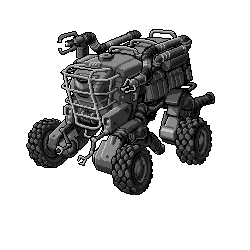
Oh, this thing is old. It predates faster than light travel by at least a century. It's a pure product of the late Low Age. A tough, reliable, versatile ground vehicle capable of adapting to any environment and use case. Name something, the EPR can do it. It's compact, it's pressurized, it can carry about anything you want, and it has cute little manipulator arms that can be used to move cargo and objects around. Propulsion is electrical and powered by an engine block that can accommodate several types of standardized power-producing units, from biofuel engines to small fission reactors. Easy to drive once you get accustomed to its main quirk — like all electric vehicles, the EPR has a lot of torque.
//EARTH-PATTERN ROVER “WEAPONIZED”
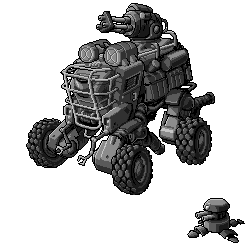
Well, technically I guess we are talking about EPRs turned into mining/excavation vehicles, but I do not think this description is entirely accurate. I've seen these things pop up here and there outside Communal Space and… I don't know, I guess an EPR can be used for excavation, but mining apparatuses also make for decent weaponry. Sub-surface displacement missiles or high-pressure water drills can turn a peaceful EPR into a mining rig and an improvised combat vehicle. It won't stand a chance in a fair fight because it has no armour to speak of, but it can definitely score a hit or two.
//MOON-PATTERN ROVER
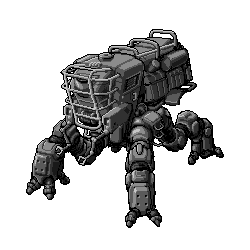
Ah, mechs. I've never been a great fan. Wheels have served us well for millennia, I don't see why we should ditch them just because we now have the technology to make stable legged designs and the autopilots to drive them. Well, I guess putting four legs on an EPR and calling it a “Moon-Pattern variant” just to flex on Earth-bound designs is typical of the Moon Communes that designed this thing and I shouldn't put too much thought into it, but…it's weird. I can't help but feel EPRs with legs are a crime against engineering. Anyway, regardless of my considerations, this is a decent evolution of the original rover. Four legs may offer better stability on rugged terrain and the ground pressure isn't ridiculously high, which is uncommon for a mech. Don't expect to drive it without a solid autopilot, though.
//SIMURGH ROVER
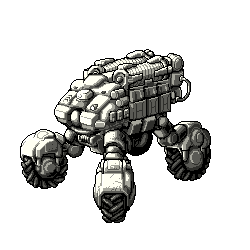
Some people think qith Saïmour wanted to have their local version of the Earth-Pattern Rover purely out of principle, but I don't think it's fair to the Eloran commune. The Simurgh is an honest attempt at modernizing the EPR and not just a rip-off. It's smaller yet has more internal space with a splendid miniaturization of the main drive, and the wheel design offers better manoeuvrability at the expense of simplicity. I am very partial to the enclosed, spaceship-like cockpit which offers much better protection, though I understand why some people don't like having to rely on external cameras.
//SIMURGH ROVER — “NOMAD”
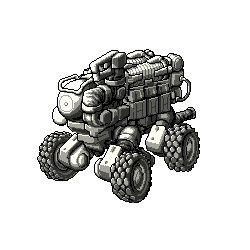
At first glance, the Nomad is what happens when you try to mix an EPR and a Simurgh, but this design is more than a ramshackle hybrid assembled by bored engineers on a rainy Sunday afternoon. I think the fairest classification I could give it is “space caravan”. The Nomad removes the manipulator arms and most of the non-essential equipment to maximize internal space and make way for habitation modules and environmental control systems. A keen eye might notice that the bubble-shaped cockpit is heavily inspired by escape pods — the resemblance is intentional, as the Nomad is designed to be assembled from discarded ship parts. In the advent of planetary colonization, the Nomad would make a perfect mobile home for the settlers. Also, it has a tea kettle.
/DJINN DRONE FAMILY
//DJINN
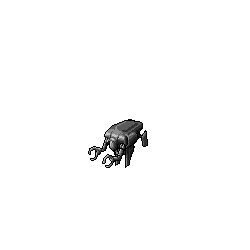
What can I say about djinns? That they are incredibly common? That they are essential to space-based activities, so much that most people don't even register them anymore? Djinns are smallish (read: human-sized) space drones that all share the same basic pattern: a CPU, manipulator arms, simple LIDAR sensors and manoeuvring thrusters. You may keep them “as is” or upgrade them with various shenanigans, but at heart, that's all they are. Free-floating drones designed to pick up and manipulate things in zero-g, a domain in which you humans are sorely lacking. Uninformed spacefarers will tell you djinns are stupid. That's just because they forgot to hook them up to a central autopilot and just let them fool around independently. Don't do that.
//LASER DJINN

“Little cyclops” I call them due to the laser emitter standing at the top of a little gimbal. This djinn design is a natural evolution of the good old laser grid system for debris and dust protection — except that instead of being stuck to the ship, our lasers can now wander around and intercept threats with more flexibility. Is it a good thing? Well, at least the people who made this pattern public domain think so. Personally, I've heard potential horror stories about laser djinn swarms used as weapons, but I don't think they have enough battery life to be a threat.
/WALKER FAMILY
//FOUR-LEGGED ASTEROID SPIDER
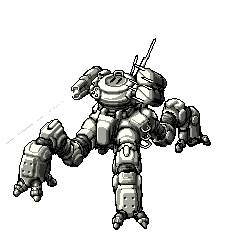
Whoever called a four-legged machine “spider” should take entomology courses but whatever, I am not here to be pedantic. This is…a thing, certainly? I'm not sure what it's supposed to be. The user manual tells me it's a mobile prospection/exploration apparatus that employs its legs as clamps to hold on to rocky asteroids, and okay, fine, but I don't see why you wouldn't use a big djinn instead. I am suspecting the spider to be an R and D reject, a failed design that a facetious engineer put in the public domain for giggles.
//LUMIA BIPEDAL WALKER
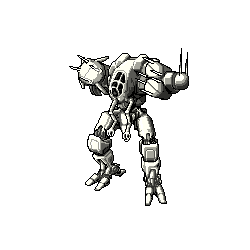
Aaaaah! Meeechs! Alright, I have to admit this one surprised me when it appeared in public domain databases about a decade ago because it is…actually not terrible? For a bipedal mech, I mean. The profile is very well-balanced, the heavy legs make it difficult to topple, ground pressure is reasonable, and the default autopilot does a fantastic job at making the mech go where you want it to go. Manipulator arms and side hardpoints mean you can attach plenty of standard tools to the Lumia which makes it a very versatile workhorse machine. Its only true weaknesses are muddy/snowy terrain (but that's true of all mechs) and heat dissipation — the Lumia is very compact. Bring a fan.
//LUMIA BIPEDAL WALKER — WEAPONIZED
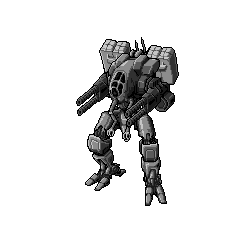
When the Lumia came out, I had my doubts as to the identity of its creators — frankly, that a small Smyrnian commune would have achieved such a good design and released it for free was surprising. When I found this alternate design in the dark corners of Eloran networks, my doubts only became stronger. The Lumia is not just an elaborate hobby project, there's something else behind it. The weaponized version is one of the few combat mechs out there that could fight outside of flower wars. Compact, very well-balanced even under fire, with a low profile, and packing a lot of weaponry for its size — quad chemical guns, an ECM jammer, eight missile pods and that's for the light version. I could see the weaponized Lumia being used as a mechanized infantry unit with good efficiency. Honestly, that a lone commune could come up with this and release it publicly keeps me awake at night — because if that's what they give for free, I wonder what they sell.
/POWERSUITS
//GRANITE HARDSUIT

It took decades for Earth militaries to refine the concept of individual powersuits, the most common of which is the Granite. Roughly man-sized (roughly — if you know someone who's as beefy as a Granite, call me) the Granite hardsuit is I think a Giants' Collective design put in public domain libraries (the copyright is a bit blurry for this one). It's…well, it's a hardsuit. Titanium-and-carbon-nanotubes-with-heavy-water-sandwich hard. Three thousand meters under the sea. Five kilometres away from a powerful radiation source. With corrosive water. And explosions. The Granite doesn't mind.
Supposedly it can survive re-entry, I have doubts about the whole deceleration business, however.
//SELENE MOBILE SUIT

I mean, it's terrifying, but it's also kind of brilliant. Powersuits make the wearer stronger and more resilient, but how about giving them more arms? Like three times more? This is a Moon Communes design which was later upgraded by the Irenians and put in the public domain — the Irenians did not originally have the rights to this design and I think publishing it was their way of settling the dispute by making the lawsuit way too annoying to handle. It's mostly a spacesuit. A top of the line spacesuit with environmental control, multiple sensor inputs, drone support, autopilot/movement assist and, well, yes, three pairs of arms, two of which are remotely controlled by the suit's mainframe.
Designs: Retrograde Minis.
All content in the Starmoth Blog is © Isilanka
Written content on Starmoth is distributed under a Creative Commons Attribution Non-Commercial Share-Alike 4.0 license
